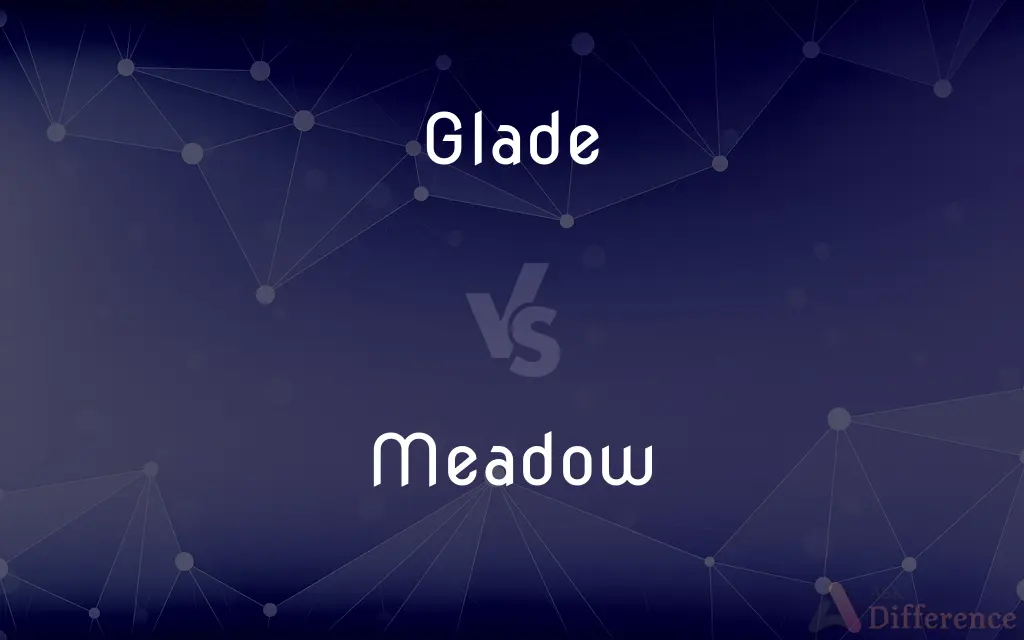Glade vs. Meadow — What's the Difference?
Edited by Tayyaba Rehman — By Fiza Rafique — Updated on March 26, 2024
A glade is a clearing within a forest, often grassy or open, while a meadow is a flat, open area of grassland, typically free from trees and found in rural landscapes.

Difference Between Glade and Meadow
Table of Contents
ADVERTISEMENT
Key Differences
Glades are characterized by their location within forests, acting as natural clearings where sunlight penetrates, encouraging the growth of grass and other sun-loving plants. These spaces can emerge due to various natural processes, such as tree falls or wildfires. On the other hand, meadows are expansive areas of grassland, usually found in open landscapes and not enclosed by forested areas. Meadows can result from natural processes or be maintained by human agricultural practices, such as mowing or grazing.
While glades are often surrounded by trees and offer a unique ecosystem that bridges forest and grassland habitats, meadows are typically larger and serve as important ecosystems for a variety of grassland species. Meadows support a wide range of flora and fauna, including many species of flowers, insects, and birds, which rely on this open habitat for food and nesting. Glades, by contrast, provide a mix of woodland and open-area species, benefiting from both the shelter provided by the surrounding forest and the sunlight of the clearing.
The creation of a glade is usually a natural occurrence, often resulting from a disturbance in the forest ecosystem that clears away trees without human intervention. In contrast, many meadows are anthropogenic, created or maintained through agricultural practices like hay cutting or livestock grazing. However, natural meadows do exist, especially in regions where forest growth is limited by factors like soil depth, moisture, or altitude.
Glades provide a significant benefit to biodiversity within forests by creating habitat variety. They offer conditions that are markedly different from the surrounding forest, supporting species that would not otherwise thrive in the dense woodland environment. Meadows, especially natural ones, play a crucial role in sustaining biodiversity in grassland ecosystems, offering habitat to a wide range of plant and animal species, some of which are highly specialized to meadow environments.
Both glades and meadows are valuable for conservation efforts. Glades are important for maintaining forest health and diversity, offering niches for species that require more light than the forest interior provides. Meadows are critical for preserving grassland species, many of which have declined due to habitat loss. Conservation efforts in these habitats focus on maintaining their unique ecological characteristics and the species that depend on them.
ADVERTISEMENT
Comparison Chart
Location
Within a forest
Open landscapes, typically not forested
Formation
Natural processes or disturbances
Natural processes or human agricultural practices
Ecosystem Type
Bridge between forest and grassland habitats
Grassland
Biodiversity
Mix of woodland and open-area species
Primarily grassland species
Size
Typically smaller than meadows
Can be extensive, covering large areas
Human Impact
Less frequently maintained by humans
Often maintained or created by human activity
Soil Conditions
Varied, often fertile from forest litter
Can vary, often managed for specific uses in agricultural contexts
Compare with Definitions
Glade
A natural clearing within a dense forest.
The deer emerged into the sunlit glade.
Meadow
A large field of grass and wildflowers.
The meadow was ablaze with color in spring.
Glade
A refuge for diverse forest-edge species.
Birdwatchers visit the glade to observe rare species.
Meadow
An open habitat for many grassland species.
Meadows provide critical habitat for endangered butterflies.
Glade
An open space surrounded by woods.
We picnicked in a glade surrounded by ancient oaks.
Meadow
A natural or human-made grassland area.
The new park includes a large meadow for public enjoyment.
Glade
A habitat for sunlight-loving plants.
Wildflowers thrive in the forest glade.
Meadow
An ecosystem supporting a wide range of flora and fauna.
The meadow ecosystem is vital for local biodiversity.
Glade
An area of increased biodiversity within forests.
The glade hosts a variety of insects not found in the dense forest.
Meadow
A pasture or hayfield in agricultural use.
Cows grazed peacefully in the meadow.
Glade
An open space in a wood or forest
A forest glade
Glades of birch
Meadow
A meadow is an open habitat, or field, vegetated by grasses, herbs, and other non-woody plants. Trees or shrubs may sparsely populate meadows, as long as these areas maintain an open character.
Glade
An open space in a forest.
Meadow
A piece of grassland, especially one used for hay
A meadow ready for cutting
143 acres of meadow and pasture
Glade
A tract of marshland.
Meadow
A tract of grassland, either in its natural state or used as pasture or for growing hay.
Glade
An open passage through a wood; a grassy open or cleared space in a forest.
Meadow
A field or pasture; a piece of land covered or cultivated with grass, usually intended to be mown for hay.
Glade
(colloquial) An everglade.
Meadow
Low land covered with coarse grass or rank herbage near rivers and in marshy places by the sea.
The salt meadows near Newark Bay
Glade
An open space in the ice on a river or lake.
Meadow
A tract of low or level land producing grass which is mown for hay; any field on which grass is grown for hay.
Glade
A bright surface of ice or snow.
A glade of ice
Meadow
Low land covered with coarse grass or rank herbage near rives and in marshy places by the sea; as, the salt meadows near Newark Bay.
Glade
(obsolete) A gleam of light.
Meadow
Of or pertaining to a meadow; of the nature of a meadow; produced, growing, or living in, a meadow.
Glade
(obsolete) A bright patch of sky; the bright space between clouds.
Meadow
A field where grass or alfalfa are grown to be made into hay
Glade
An open passage through a wood; a grassy open or cleared space in a forest.
There interspersed in lawns and opening glades.
Glade
An everglade.
Glade
An opening in the ice of rivers or lakes, or a place left unfrozen; also, smooth ice.
Glade
A tract of land with few or no trees in the middle of a wooded area
Common Curiosities
What defines a glade?
A glade is a natural clearing within a forest, often grassy or filled with sunlight-loving plants.
Are meadows always natural formations?
No, meadows can be natural or maintained by human agricultural practices like mowing or grazing.
Why are glades important for biodiversity?
Glades increase biodiversity within forests by providing a habitat for species that require more light than the forest interior offers.
What causes the formation of a glade?
Glades form due to natural forest disturbances that clear away trees, such as tree falls or wildfires.
What is the significance of meadows in agriculture?
Meadows are used as pasture or hayfields, playing a significant role in livestock grazing and fodder production.
How does a meadow differ from a glade?
Meadows are open areas of grassland, typically found in open landscapes and not enclosed by forest, unlike glades which are forest clearings.
What role do meadows play in an ecosystem?
Meadows support a diverse range of flora and fauna, serving as crucial habitats for many grassland species.
Can glades and meadows support the same types of species?
While there might be some overlap, glades typically support a mix of woodland and open-area species, whereas meadows are home to primarily grassland species.
How are glades and meadows maintained?
Glades are less frequently maintained by humans, relying on natural processes, while many meadows are maintained or created through agricultural practices.
How do human activities affect glades and meadows?
Human activities, especially agriculture and urban development, can alter or destroy these habitats, affecting their biodiversity.
Can meadows form in areas where forests are not present?
Yes, meadows can form in open landscapes without the need for forest clearance, unlike glades which are specifically forest clearings.
Do conservation efforts focus on both glades and meadows?
Yes, both are valuable for conservation, focusing on preserving their unique ecological characteristics and the species that depend on them.
Are there specific plants that are unique to glades?
Yes, some plants thrive in the sunlight of glades and may not be found in the denser parts of the forest.
What makes meadows important for environmental conservation?
Meadows are critical for sustaining biodiversity, especially for grassland species that have declined due to habitat loss.
How do soil conditions in glades and meadows compare?
Soil conditions in glades can be fertile due to forest litter, while meadow soils can vary and are often managed for specific agricultural uses.
Share Your Discovery

Previous Comparison
Ship vs. Ark
Next Comparison
Immortal vs. InvincibleAuthor Spotlight
Written by
Fiza RafiqueFiza Rafique is a skilled content writer at AskDifference.com, where she meticulously refines and enhances written pieces. Drawing from her vast editorial expertise, Fiza ensures clarity, accuracy, and precision in every article. Passionate about language, she continually seeks to elevate the quality of content for readers worldwide.
Edited by
Tayyaba RehmanTayyaba Rehman is a distinguished writer, currently serving as a primary contributor to askdifference.com. As a researcher in semantics and etymology, Tayyaba's passion for the complexity of languages and their distinctions has found a perfect home on the platform. Tayyaba delves into the intricacies of language, distinguishing between commonly confused words and phrases, thereby providing clarity for readers worldwide.













































